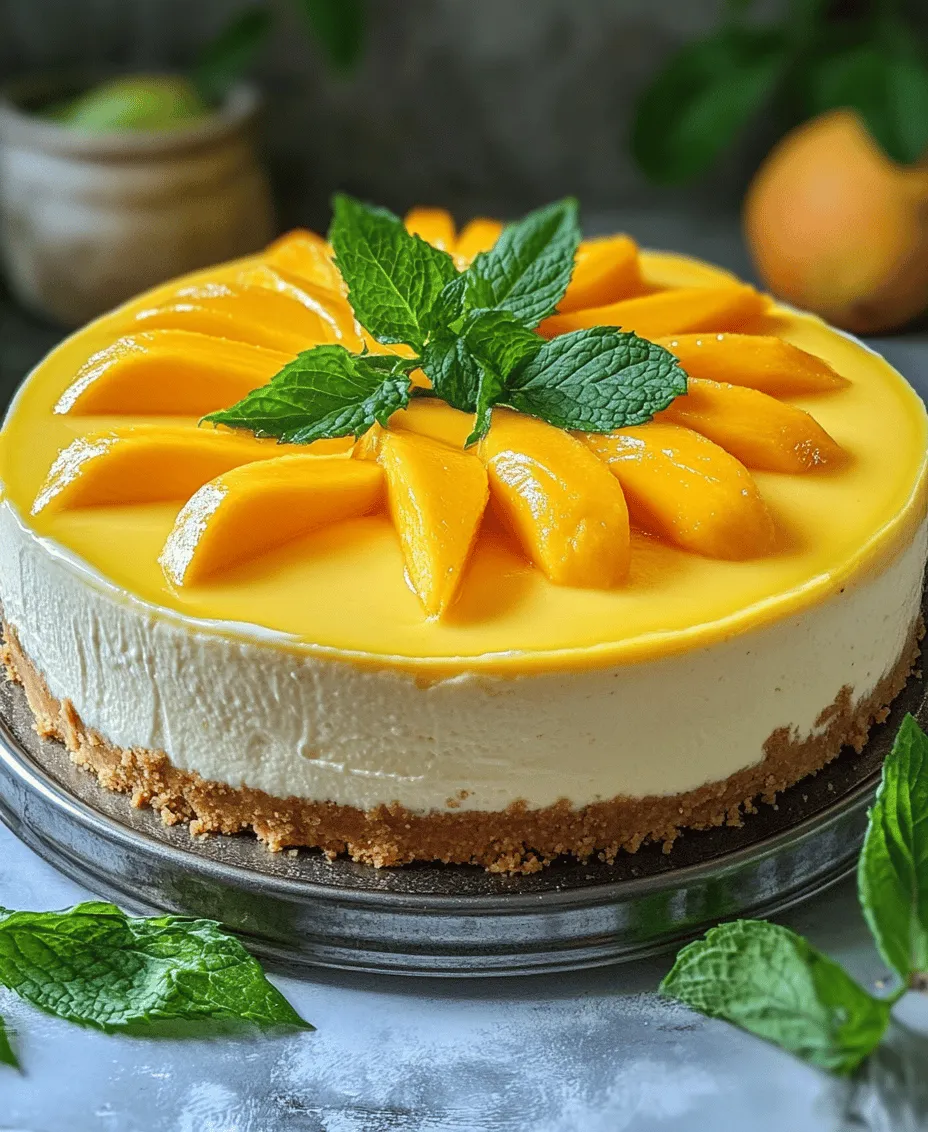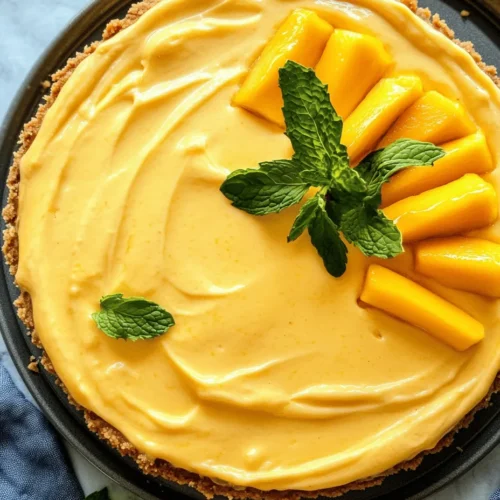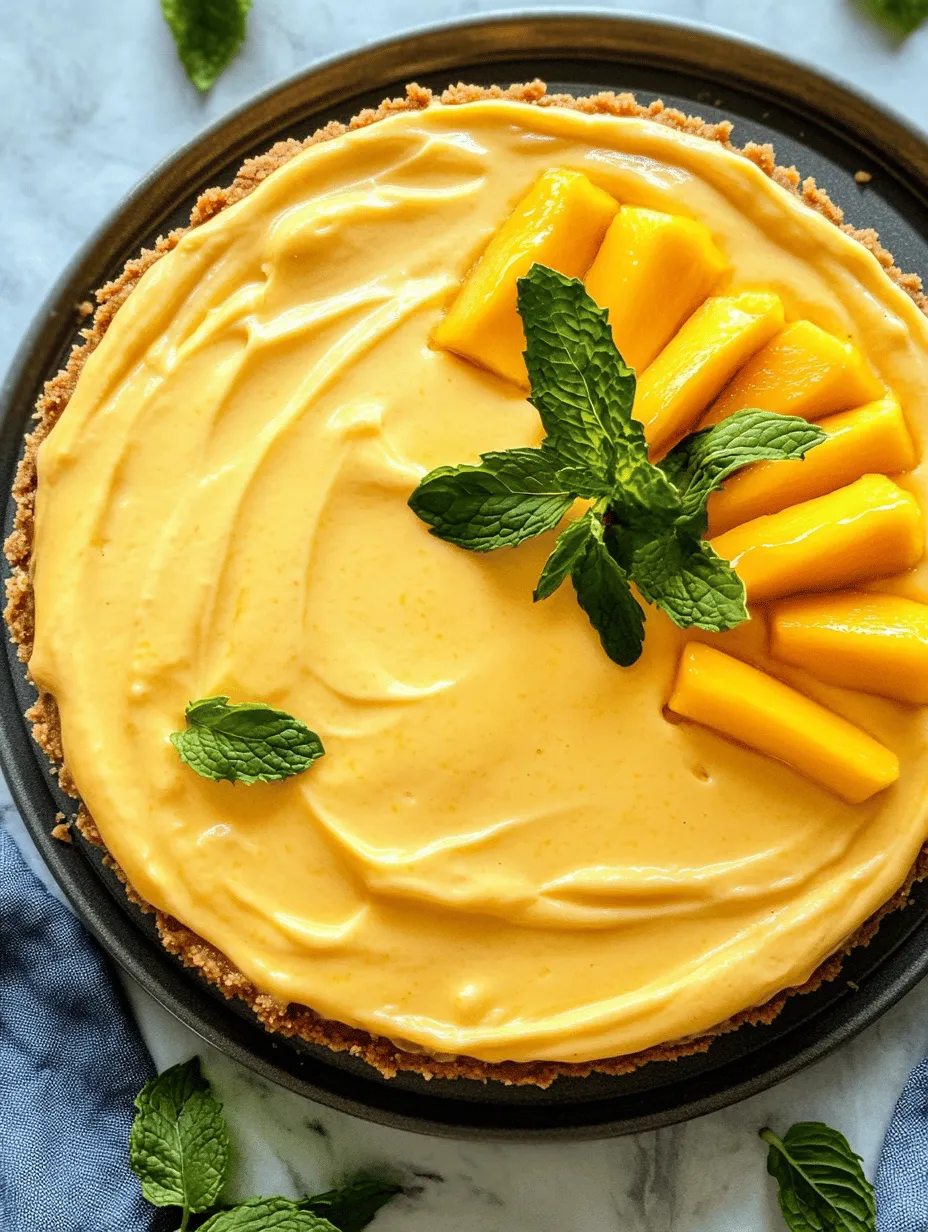Introduction
Mango cheesecake is a delightful dessert that combines the rich and creamy texture of traditional cheesecake with the vibrant flavors of tropical mangoes. This dessert not only tantalizes the taste buds but also provides a visual feast with its sun-kissed color. Perfect for any occasion, whether it’s a summer gathering, a birthday celebration, or a cozy family dinner, this cheesecake offers a refreshing twist that is sure to impress your guests. The sweet, tangy flavor of ripe mangoes harmonizes beautifully with the velvety cream cheese, creating an indulgent experience that captures the essence of tropical bliss.
As we delve into the world of mango cheesecake, we will explore its fascinating background, the essential ingredients that contribute to its lusciousness, and provide you with a detailed step-by-step guide to making this dessert from scratch. By the end of this article, you’ll be equipped with everything you need to create a stunning mango cheesecake that will leave everyone asking for seconds.
Understanding the Ingredients
Creating a perfect mango cheesecake starts with understanding the key ingredients that contribute to its unique flavors and textures. Each component plays a crucial role in crafting this creamy delight.
Graham Cracker Crust
The foundation of any great cheesecake lies in its crust, and for mango cheesecake, a graham cracker crust is the ideal choice. This crust adds a delightful crunch that complements the smooth filling.
Importance of the Crust in Cheesecake
A well-made crust not only provides structure to the cheesecake but also adds a contrasting texture that enhances the overall eating experience. The buttery flavor of the graham crackers pairs perfectly with the creamy filling, creating a balanced bite.
Ingredients and Their Roles
A traditional graham cracker crust typically consists of crushed graham crackers, melted butter, and sugar. The graham crackers provide the bulk of the crust, while the butter acts as a binding agent, helping to hold the crumbs together. A bit of sugar adds sweetness, which is essential to offset the tartness of the cream cheese filling.
Cream Cheese Filling
The heart of any cheesecake is its filling, and in this recipe, cream cheese is the star ingredient.
Why Cream Cheese is Essential for Texture
Cream cheese is known for its smooth and creamy texture, which is vital for achieving that classic cheesecake consistency. Its rich flavor complements the sweetness of mango, creating a harmonious blend that is both indulgent and refreshing.
Variations in Cream Cheese Types
While traditional full-fat cream cheese is commonly used, you can experiment with low-fat or flavored cream cheeses for a different taste profile. Keep in mind that the texture may change slightly depending on the type you choose, so it’s essential to ensure that whichever cream cheese you use is soft enough to blend smoothly.
Mango Puree
Mango is the star of this cheesecake, providing both flavor and color.
Fresh vs. Canned Mango: Advantages and Disadvantages
When making mango puree, you can choose between fresh or canned mango. Fresh mangoes are ideal for their vibrant flavor and natural sweetness, but they require proper selection and ripening. On the other hand, canned mango puree is convenient and consistent in flavor, though it may contain added sugars or preservatives. If you opt for fresh mangoes, be sure to select ripe ones that yield slightly to pressure for the best results.
Nutritional Benefits of Mangoes
Mangoes are not only delicious but also packed with essential nutrients. They are rich in vitamins A and C, which are beneficial for skin health and immune function. Additionally, mangoes contain antioxidants that can aid in digestion and promote overall health, making this dessert a guilt-free indulgence.
Gelatin or Agar-Agar
To achieve the perfect texture, setting agents like gelatin or agar-agar are essential.
Purpose of Gelatin in Setting the Cheesecake
Gelatin helps to stabilize the cream cheese filling, giving the cheesecake its characteristic firmness while still maintaining a creamy mouthfeel. This is particularly important in no-bake cheesecakes, allowing them to hold their shape when sliced.
Vegetarian Alternatives and How They Work
For those following a vegetarian diet, agar-agar is an excellent alternative to gelatin. Derived from seaweed, agar-agar acts similarly to gelatin but sets at room temperature and creates a firmer texture. When using agar-agar, it’s important to follow the package instructions carefully, as the ratios and preparation methods differ from traditional gelatin.
Heavy Whipping Cream
To elevate the cheesecake and provide a light, airy texture, heavy whipping cream is incorporated.
Role of Whipped Cream in Providing Lightness
The addition of whipped cream to the filling lightens the overall texture, balancing the density of the cream cheese. This adds a luscious creaminess that makes each bite feel indulgent without being overly heavy.
Tips for Achieving the Perfect Texture
To whip cream successfully, ensure your mixing bowl and beaters are cold, as this helps the cream whip faster and achieve maximum volume. Whip until soft peaks form, being careful not to over-whip, which can lead to a grainy texture. The whipped cream should be gently folded into the cream cheese mixture to maintain its airy quality.
Step-by-Step Instructions for Making Mango Cheesecake
Now that we have a good understanding of the ingredients, it’s time to dive into the step-by-step process of creating your tropical dessert from scratch. Follow these detailed instructions to make a luscious mango cheesecake that will wow your friends and family.
Preparing the Graham Cracker Crust
1. Crush the Graham Crackers
Start by placing your graham crackers in a food processor. Pulse them until they resemble fine crumbs. If you don’t have a food processor, you can place the crackers in a zip-top bag and crush them with a rolling pin.
2. Mix with Butter and Sugar
In a mixing bowl, combine the crushed graham crackers with melted butter and sugar. Use a fork to mix until all the crumbs are evenly coated with butter. The mixture should resemble wet sand.
3. Press into the Pan
Transfer the crust mixture into a 9-inch springform pan. Use the back of a measuring cup or your fingers to press the mixture firmly into the bottom of the pan and up the sides if desired. This will create a sturdy base for your cheesecake.
4. Chill the Crust
Place the crust in the refrigerator for at least 30 minutes to set. This step is crucial as it helps the crust hold its shape once the filling is added.
Making the Mango Puree
1. Select and Prepare Fresh Mangoes
If you’re using fresh mangoes, start by peeling and pitting them. Cut the flesh into chunks and place them in a blender or food processor.
2. Blend to a Smooth Consistency
Blend the mango chunks until smooth. If the mixture is too thick, you can add a tablespoon of water or lemon juice to help it blend. Taste the puree and adjust the sweetness if necessary, adding sugar or honey to enhance the flavor.
3. Set Aside
Once blended, set the mango puree aside while you prepare the cheesecake filling.
Dissolving the Gelatin
1. Bloom the Gelatin
If using gelatin, start by sprinkling it over a small bowl of cold water (about ¼ cup). Allow it to sit for 5-10 minutes until it swells. This process is known as blooming and is essential for ensuring the gelatin dissolves evenly.
2. Heat to Dissolve
After blooming, heat the gelatin mixture gently in the microwave for 10-15 seconds or over a double boiler until it becomes liquid. Avoid boiling it, as high temperatures can damage the gelling properties.
3. Alternative Methods for Dissolving Agar-Agar
If you’re using agar-agar, dissolve it in boiling water according to package instructions. Usually, this involves simmering it for a few minutes until fully dissolved.
Crafting the Cheesecake Filling
1. Beat the Cream Cheese
In a large mixing bowl, beat the softened cream cheese with an electric mixer until it’s smooth and creamy. This step is crucial for a lump-free filling, so take your time to blend well.
2. Incorporate Sugar and Vanilla
Gradually add sugar and vanilla extract to the cream cheese, mixing until fully combined. Taste the mixture to adjust sweetness according to your preference.
3. Mix in the Gelatin
Once the gelatin is dissolved, allow it to cool slightly before adding it to the cream cheese mixture. Mix well to ensure an even distribution throughout the filling.
4. Fold in the Whipped Cream
In a separate bowl, whip the heavy cream until soft peaks form. Gently fold the whipped cream into the cream cheese mixture using a spatula. Be careful not to deflate the whipped cream, as this will maintain the lightness of the filling.
Combining Mango and Cream Cheese Mixtures
1. Combine the Puree and Filling
Gently fold the mango puree into the cream cheese filling until fully combined. Ensure you do this carefully to keep the mixture light and airy.
2. Pour into the Crust
Once combined, pour the mango cheesecake filling into the chilled graham cracker crust. Smooth the top with a spatula for an even finish.
3. Chill Until Set
Cover the cheesecake with plastic wrap and refrigerate for at least 4-6 hours, or overnight if possible. This chilling time allows the cheesecake to set properly and ensures that each slice holds its shape.
With these detailed steps, you’re well on your way to creating a creamy, tropical mango cheesecake that will surely impress. Continue following the remaining instructions to complete your dessert, and get ready to enjoy a slice of tropical bliss!

Importance of Gentle Folding
When it comes to making a mango cheesecake, gentle folding is crucial to achieving a light and airy texture that complements the creamy filling. After whipping the cream, you’ll want to incorporate it into the mango mixture without deflating the air that was incorporated during whipping. This step is key to maintaining the cheesecake’s fluffiness.
To fold properly, use a spatula or large spoon. Start by adding a small portion of the whipped cream to the mango mixture. Using a figure-eight motion, gently mix the ingredients, rotating the bowl as you go. Repeat this process, gradually adding more whipped cream until fully combined. Avoid vigorous stirring as it can lead to a dense texture.
Tips for Avoiding Lumps
Lumps in your cheesecake can disrupt the smooth, creamy texture that you strive to achieve. Here are some tips to avoid lumps when making your mango cheesecake:
1. Room Temperature Ingredients: Ensure all your ingredients, especially cream cheese, are at room temperature. Cold cream cheese can lead to lumps when mixed.
2. Thorough Mixing: Use an electric mixer to beat the cream cheese until smooth before adding any other ingredients. Scrape down the sides of the bowl to ensure even mixing.
3. Sifted Ingredients: If you’re using powdered sugar, consider sifting it before mixing it in. This can help prevent clumps from forming.
4. Straining the Mango Puree: If your mangoes are particularly fibrous, straining the puree can help achieve a smoother consistency.
Whipping the Cream
Whipping cream is a delicate process that can make or break your cheesecake. Here’s how to do it perfectly.
Techniques for Perfect Soft Peaks
1. Chill the Equipment: Before whipping, chill your mixing bowl and beaters in the refrigerator for about 15 minutes. Cold equipment helps the cream whip faster and better.
2. Start Slow: Begin whipping the cream at a low speed to avoid splattering. Gradually increase the speed as the cream starts to thicken.
3. Watch for Soft Peaks: Keep an eye on the cream as it whips. You’re aiming for soft peaks, where the cream holds its shape but is still smooth and glossy. This usually takes about 3-5 minutes of whipping.
Handling Whipped Cream with Care
Once you’ve achieved soft peaks, it’s essential to handle the whipped cream with care to preserve its structure. Avoid overmixing, which can turn the cream into butter. If you notice the cream becoming grainy, stop whipping immediately.
Assembling the Cheesecake
Once you have your mango mixture and whipped cream ready, it’s time to assemble your cheesecake.
Pouring Techniques for an Even Layer
When pouring the mango filling into the crust, do it slowly and evenly. Start in the center, allowing the mixture to naturally spread out toward the edges. You can also tap the pan gently on the counter to release any air bubbles trapped in the filling. This technique helps ensure that your cheesecake has a smooth top and an even distribution of mango flavor.
Importance of Refrigeration for Optimal Setting
After pouring the mixture into the crust, it’s crucial to refrigerate the cheesecake for at least 4-6 hours, or ideally overnight. This allows the cheesecake to set properly, achieving that perfect sliceable consistency. The longer it sits, the more the flavors meld together, enhancing the overall taste.
Garnishing and Serving Suggestions
Garnishing your mango cheesecake not only adds visual appeal but also enhances the flavor experience. Here are some ideas to elevate your presentation.
Choosing the Right Garnishes
1. Fresh Mango Slices: For a fresh and vibrant garnish, thinly slice ripe mangoes. Arrange them on top of the cheesecake in a decorative pattern. To cut the mango, slice down each side of the pit, then create cross-hatch cuts in the flesh before scooping out the pieces with a spoon.
2. Adding Mint Leaves: Fresh mint leaves offer a pop of color and a refreshing flavor contrast. Place a few sprigs on top or alongside your cheesecake for a beautiful garnish.
Serving Recommendations
To enhance the indulgence of your mango cheesecake, consider these serving suggestions:
– Ideal Accompaniments: Pair the cheesecake with a dollop of freshly whipped cream or a drizzle of fruit coulis, such as passionfruit or raspberry, for a vibrant touch.
– Pairing with Beverages: Serve your mango cheesecake alongside tropical cocktails, such as a piña colada or mojito, for a complete tropical experience. Iced tea with a hint of lemon or peach is also a refreshing pairing.
Nutritional Information
As with any dessert, understanding the nutritional value can help you enjoy it mindfully.
Caloric Breakdown
A typical slice of mango cheesecake (about 1/8 of a 9-inch cheesecake) contains approximately 300-350 calories. This can vary based on the specific ingredients and portion sizes. It’s always a good practice to calculate the nutritional values based on the ingredients you use.
Health Benefits of Key Ingredients
1. Mangoes: Rich in vitamins A and C, mangoes provide antioxidants that contribute to overall health. They also contain fiber, which aids in digestion.
2. Cream Cheese: While cream cheese is high in fat, it also provides calcium and protein, essential for bone health and muscle maintenance.
3. Sugar: While sugar adds sweetness, it’s important to consume it in moderation. Using natural sweeteners can help reduce calories while maintaining flavor.
Tips for Health-Conscious Modifications
For those looking to make healthier choices, here are some modifications you can implement:
– Reducing Sugar: Use less sugar than the recipe calls for, or substitute with natural sweeteners like honey or agave syrup.
– Lower-Calorie Options: Consider using reduced-fat cream cheese or a combination of Greek yogurt and cream cheese to cut down on calories while still achieving a creamy texture.
Cultural Significance of Mango Cheesecake
Mango cheesecake is more than just a dessert; it embodies cultural meanings and culinary traditions across the globe.
Mango in Culinary Traditions
Mangoes are celebrated in various cuisines, particularly in tropical regions where they are abundant. In many cultures, mangoes symbolize joy and abundance, often featured in festive dishes and desserts. The fruit’s sweet, rich flavor makes it a favorite in desserts, salads, and salsas.
Cheesecake Variations Around the World
Cheesecake exists in numerous forms around the world. For instance, the New York-style cheesecake is rich and dense, while Italian ricotta cheesecake is lighter and often flavored with citrus. The mango cheesecake combines these traditions, offering a unique tropical twist that has gained popularity.
The Rise of Tropical Flavors in Desserts
In recent years, tropical flavors have surged in popularity within the dessert scene. As people seek refreshing and unique tastes, fruit-based cheesecakes like mango cheesecake have become favorites. This trend reflects a broader interest in global cuisines and flavors, allowing home cooks to experiment and create dishes that transport them to distant lands.
Conclusion
Mango cheesecake is not just a dessert; it’s an experience that combines the creamy richness of traditional cheesecake with the refreshing sweetness of mangoes. By following this detailed recipe and understanding the components and cultural significance, you can create a stunning dessert that delights the senses and brings a taste of the tropics to your table. Whether for a special occasion or a casual gathering, this creamy slice of tropical bliss is sure to be a favorite among friends and family. With its vibrant flavors and creamy texture, mango cheesecake is a delightful treat that will leave everyone coming back for seconds.


